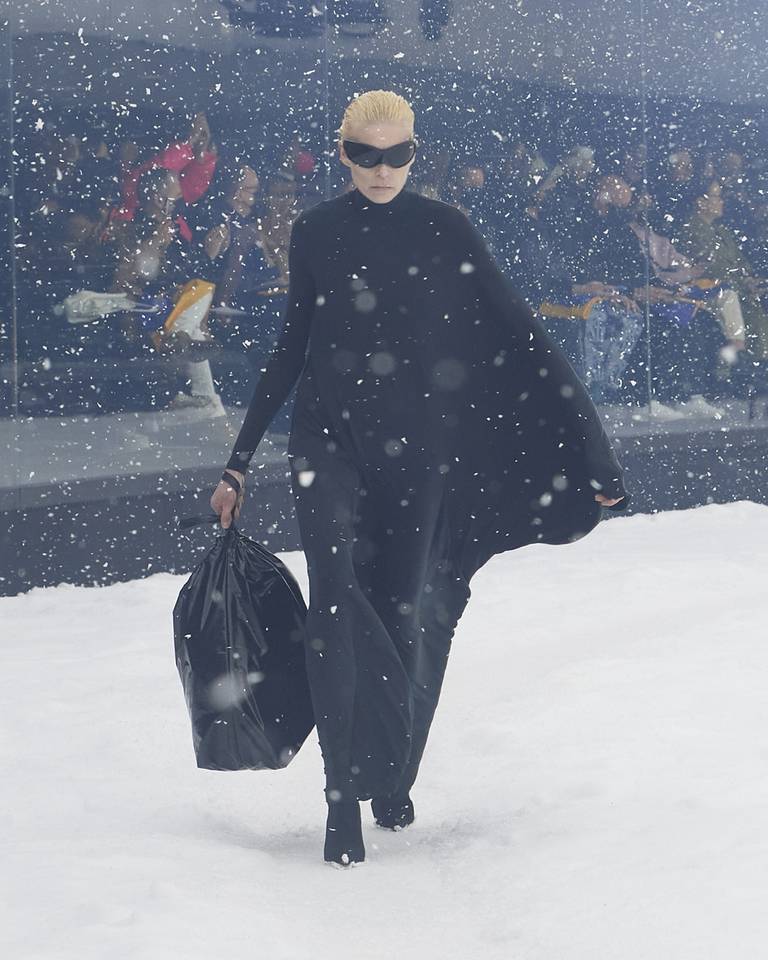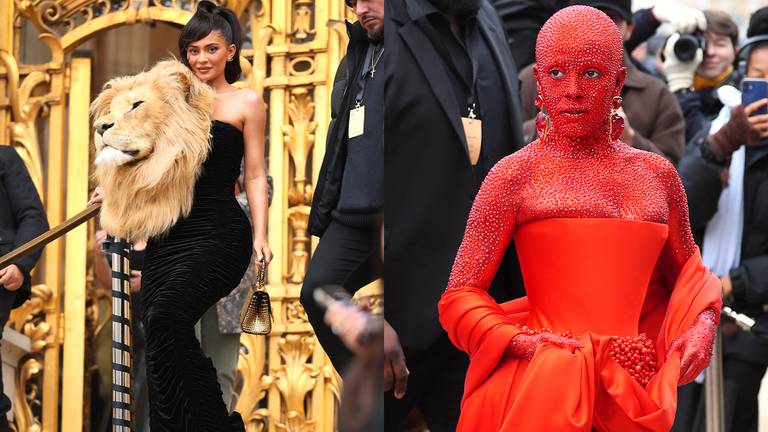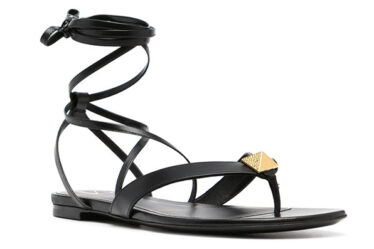
How gagged should a fashion fan be? “Very” seems to be the answer if recent seasons are any indication.
This year alone, fashion stunts, gags and gimmicks — seemingly calibrated to go viral online — have included celebrities in faux taxidermy gowns at Schiaparelli, Harry Styles’ crystal Egonlab romper at the Grammys, Sam Smith’s inflatable Harri pants at the Brit Awards and models scampering down the runway in animal prosthetics at Collina Strada. And that’s only through February.
Whether it’s dressing celebrities in over-the-top looks, churning out meme-able products, or staging runways shows with clear storytelling hooks, brands have turned to stunts in a fast-paced media environment where competition for attention is more intense than ever.
For nearly a decade, the rise of social media algorithms — which favour provocation by detecting and amplifying debate — coincided with a fashion cycle where bold statements from brands like Balenciaga and Gucci drove the fashion conversation.
But even as the pace of viral fashion moments hits an all-time high, some brands are easing away from the approach, which comes with both risks and rewards and may be difficult to sustain.
“For brands that were using communications coups to maximise visibility, it became more than a coup, it became their way of marketing,” said communications consultant Youssef Marquis, who previously worked at Louis Vuitton and Givenchy. “They get trapped in a race for the next, bigger viral moment.”
This weekend in Paris, Kering’s Balenciaga plans to reboot with an understated, archival approach after years of creating “lightning rod” moments on social media with products like leather trash bags and bedazzled platform crocs; campaigns including dystopian newscasts; and red-carpet stunts like shrouding Kim Kardashian’s face and body at the Met Gala. Those moments often provoked delight and distaste in equal measure, fuelling online buzz — and booming revenues.
Balenciaga’s sales have slowed sharply, however, since the brand faced widespread backlash last November for including S&M-inspired products in a campaign featuring children. Although designer Demna has insisted the misstep was never intended to provoke, the fallout has caused the brand to rethink the way it courts attention.
Gucci, which for years drove the fashion conversation with campy, twisted attire and shows that included models walking through fire, carrying dragons and severed heads, or parading hand-in-hand with their identical twins, has pulled back on stunts, too, as it refocuses on telling its heritage story after the departure of designer Alessandro Michele.
But Balenciaga and Gucci aren’t the only brands reevaluating their approach. The use of “earned media” metrics that valorise quantity — rather than quality — of online discussion has become pervasive in the fashion industry in recent years, but all buzz isn’t good buzz.
“Some houses are starting to reconsider their recipe for buzz, moving away from a logic of volume,” said Claire Gallon, who advises luxury brands for The Salmon Consulting in Paris. How buzz is actually contributing to a brand’s desirability is back in focus — as are the risks when things boil over.
For smaller brands, courting viral buzz can feel like an imperative in order to compete with big rivals. But virality can be a double-edged sword, as with the reaction to Schiaparelli’s use of faux taxidermy during the haute couture season in January. The small Paris house — which claims to never pay its celebrity clients — dressed Kylie Jenner and Doja Cat in looks that were social-media catnip, garnering visibility worth an estimated $45 million in earned media, according to consultancy Launchmetrics.
The discourse was far from entirely positive: Schaiparelli’s faux taxidermy — inspired by Dante, designer Daniel Roseberry said — went viral not just because the pieces were visually striking, but because many thought Jenner was wearing a real lion’s head, while others accused the brand of glamourising big game hunting and its colonial overtones whether the lion was real or not.
Still, the buzz from Schiaparelli’s couture outing exceeded what multi-billion-dollar brands like Chanel and Dior were able to generate that season with a well-stocked bench of paid ambassadors.
“Thanks to these moments there’s an awareness about these brands and creations, which there otherwise just wouldn’t be,” said Lucien Pagès, the Paris-based PR guru who represents both Schiaparelli and Coperni, the emerging label that “won” Paris fashion week last September with a viral moment in which Bella Hadid’s Coperni slip dress was spray-painted live on the runway.
Despite the perceived intensity of many social media firestorms —”under the umbrella of controversy you have many layers—, some which are acceptable,” he added. “If you respect your audience, you can play with provocation.”
But looking ahead, more of fashion’s biggest brands appear to be refocusing resources on purchasing steadier, more controlled visibility through ambassador deals with mainstream stars who can be expected to plug the brand in a “safe” way — putting the “free” buzz from viral chatter on the back burner.

“Right now it may make sense to invest in hyper-visibility, but as brands look ahead they’re thinking about whether it works to constantly surprise, or whether this is actually leading to a banalisation of brand awareness,” The Salmon’s Gallon said. “When brands are all pulling on that same thread, customers forget who was even behind each [stunt].”
For smaller businesses, creating a viral buzz is still often seen as the best way to compete for visibility, with the potential reward outweighing risks. Sure, Sam Smith was mocked by some users online as “desperate for attention” when he turned up on the Brit Awards red carpet wearing an inflatable look by Harri. But the look was true to both Smith and the label’s vision, and helped put the designer on the map. Harri says he’s since seen demand take off for custom projects like music videos and performances: even for a nascent business, viral buzz is most valuable when it’s aligned with a brand’s unique identity and ambitions.
“There’s just so many brands that the small ones can’t resist the attraction of a viral moment. It can be a fatal attraction, though, because then how do you live up to it?,” Marquis said. “The strongest feat for a young brand is to create an identity, to message uniqueness.”



